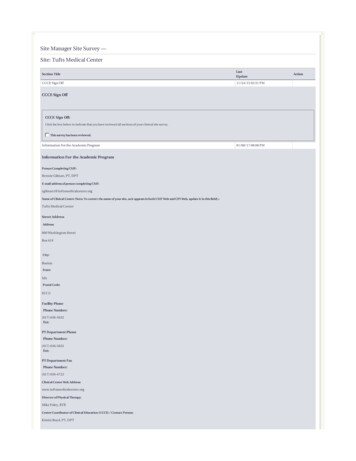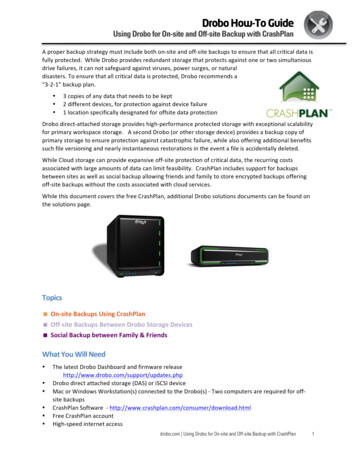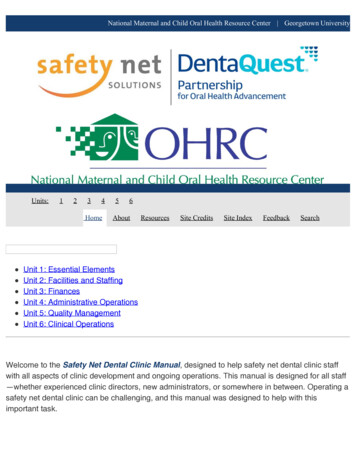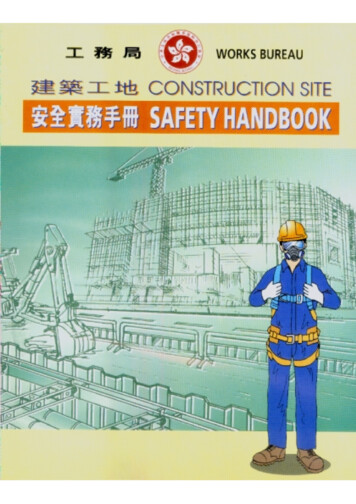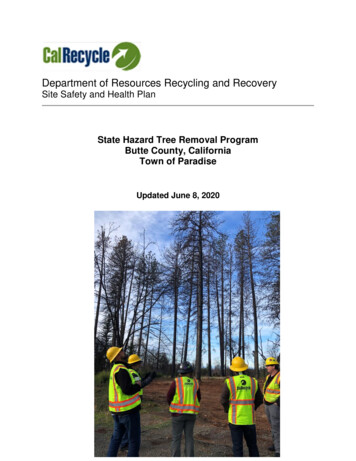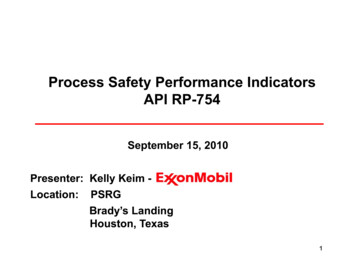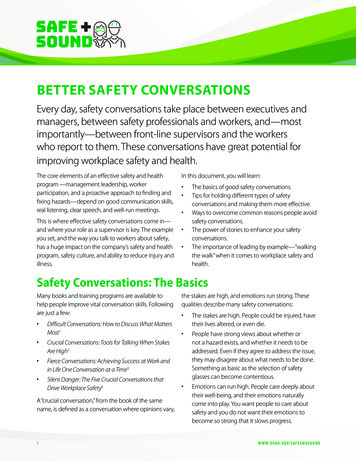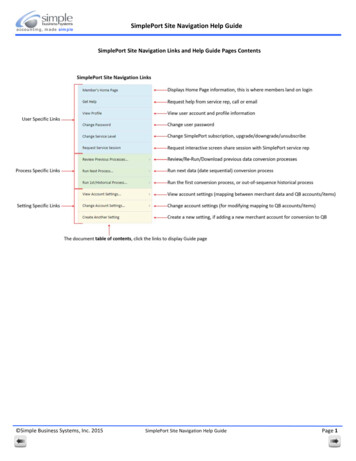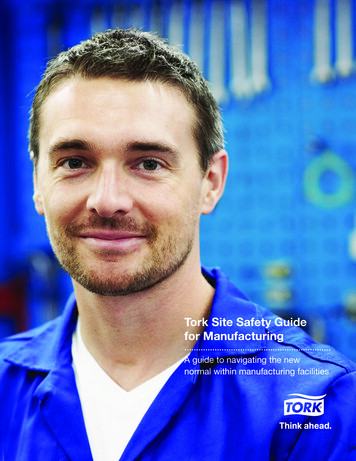
Transcription
Tork Site Safety Guidefor ManufacturingA guide to navigating the newnormal within manufacturing facilities
A Message from TorkManufacturing undoubtedly plays a critical role in the economyand maintaining supply chains. As manufacturers begin to reopentheir facilities, it is important that we work together to safely andresponsibly continue production of essential and non-essentialitems that fulfill the needs of our communities, all while prioritizingthe health and wellbeing of employees.To achieve this, collaboration is critical. In this spirit, Torkhas developed this guide to offer insights from our first-handexperience. By working closely with trade unions, industry bodies,and public health officials, we have outlined the practical stepsTork has taken to address workplace safety and hygiene concernsacross our manufacturing sites. Although these guidelines should notbe used in place of local, regional or national mandates, they can serveas concrete examples for how new safety protocols can be effectivelyincorporated into daily operations to protect employee health.It is our hope that in sharing these measures and best practicesguided by World Health Organization (WHO) recommendations*, ourpeers and customers across the manufacturing industry can furtherpromote hygienic work environments and reopen facilities safely.The road ahead may be uncertain, but together, we will secure thenew hygiene standard.Best wishes,Jenny TurnerJenny TurnerMarketing Director – ManufacturingEssity Professional Hygiene
Safety GuidelinesSocial Distancing Rules1.Keep proper physical distance (2 metres / 6 feet) betweenco-workers in the facility.2.All efforts should be followed to prevent employees fromworking in close proximity, but this may be unavoidable forcertain critical tasks. If a task requires employees to workwithin 2 meters or 6 feet of one another, employees must weareither a face shield or closely fitting safety glasses and a facemask / covering.3.Where work stations cannot be moved and in instances wheresocial distancing isn’t feasible, consider other options, suchas implementing plastic shields or dividers as an additionalbarrier between employees on production lines.4.Avoid handshaking or any other close-contact activitiesthat interfere with or prevent social distancing within yourmanufacturing facility.Where work stations cannot be adjusted consider implementingplastic shields as an additional barrier between employeesHigh-Traffic Areas and People FlowCreate zones in break rooms, cafeterias, meeting rooms tomaintain social distancing requirements.1.Use door stops to keep high traffic/commonly-useddoors open, when safe to do so.2.Encourage employees to use one door for entering rooms,and another for leaving to avoid close contact of colleaguescoming and going.3.Create zones in break rooms, cafeterias, meeting rooms andother common areas that are typically high-traffic to maintainsocial distancing requirements.QUICK TIPS2 metres6 feetKeep properphysical distancebetween co-workersin the facility.Use door stops tokeep high traffic/commonly-useddoors open, whensafe to do so.Encourageemployees to useone door for enteringrooms, and anotherfor leavingFor additional information on keeping your facility safe, visit tork.co.uk/cleancaremanufacturing*Practices and protocols may vary by region and location.
Safety GuidelinesPersonal Protective Equipment (PPE)A face covering, such as a face mask, or other appropriate facecovering, is recommended to be worn whenever possible inshared areas within the workplace.1.Based on local guidelines, a face covering, such as a facemask or other appropriate face covering, is recommendedto be worn whenever possible in shared areas withinthe workplace.2.Consider different mask types based on your facility’s needs.3.For tasks where 2 workers need to work within 2 metres or6 feet, employees must wear either a face shield or closelyfitting safety glasses and a face mask / covering.4.For employees using reusable masks or face coverings, theirPPE should be cleaned regularly and should not be shared.5.Gloves should be worn to bolster hand hygiene, but do notreplace frequent hand-washing requirements.6.Glasses are effective in limiting hand-to-eye contact (incombination with appropriate mouth nose coverings), butdo not fully prevent the transmission of airborne dropletscontaining pathogens.Signage1.Use visual cues to reinforce the ongoing education ofhand hygiene best practices. This is especially helpfulfor workers on long shifts, as these cues keep handhygiene top of mind.2.Place signage in workstation, high-traffic anddesignated sanitization areas to strengthen handhygiene compliance and protocols across your facility.Place signage in workstation, high-traffic and designatedsanitization areas to strengthen hand hygiene compliance.QUICK TIPSA face mask isrecommended tobe worn wheneverpossible in sharedareas within theworkplace.Gloves may be usedto bolster handhygiene, but do notreplace frequenthand-washingrequirements.Use visual cuesto reinforce theongoing educationof hand hygiene bestpracticesFor additional information on keeping your facility safe, visit tork.co.uk/cleancaremanufacturing*Practices and protocols may vary by region and location.
Cleaning ProtocolsHand & Respiratory Hygiene1.Employees should wash their hands frequently (or usehand sanitizer containing at least 70% alcohol* when handwashing isn’t feasible and hands aren’t visibly soiled). Eachtime, employees should dedicate at least 40 seconds tothis routine2.Respiratory hygiene is equally as important. Use papertowels or tissues to cover sneezes and coughs and discardthem in covered waste bins afterward.Hygiene Stations1.Location and accessibility of hygiene products andhand-washing stations are critical to ensure hand hygienecompliance.2.Place sanitizing stations throughout walking routes andcorridors to ensure accessibility for staff on-the-go.Alcohol solutions with at least 70% alcohol should be effectiveto disinfect and clean surfaces.Place sanitizing stations throughout walking routes andcorridors to ensure accessibility for staff on-the-go.Increased Cleaning1.Surfaces should be cleaned and disinfected at least onceper shift, and more frequently for high-traffic periods andareas.2.Diluted bleach solutions, alcohol solutions with at least 70%alcohol*, and most common locally-registered householddisinfectants should be effective to disinfect and cleanthese surfaces.3.Encourage employees to clean and disinfectant commontouch points, such as tables, chairs, HMIs (human andmachine interface) and keyboards, in communal areasbefore / after use and at the beginning /end of every shift.Employees should have easy access to disinfectantsand cleaning solutions to ensure they’re able to maintainhygiene practices.QUICK TIPSEmployees shouldwash their handsfrequently for 40seconds.Surfaces should bedisinfected at leastonce per shift, andmore frequently forhigh-traffic periodsand areas.Accessibility ofhygiene productsand hand-washingstations are critical toensure hand hygienecompliance.For additional information on keeping your facility safe, visit tork.co.uk/cleancaremanufacturing*Practices and protocols may vary by region and location.
Employees FirstPreparedness & Safety1.Establish and maintain transparent communication withemployees and your community to ensure your staff iswell informed and up to date on the latest protocols andprocedures before returning to the workplace.2.Other safety measures, such as contact tracing andtemperature checks, should be implemented ahead ofreopening to reduce the risk of virus spread both insideand outside of your facility.Temperature checks should be implemented ahead ofreopening to reduce the risk of virus spread both inside andoutside of your facility.Employee Training1.Conduct training sessions so that employees areeducated on and aware of symptoms. For a full list ofsymptoms visit the European Centre for DiseasePrevention and Control (EU) or Centers for DiseaseControl and Prevention (U.S.) websites, based on youroperating facility’s location.2.Implement additional video training sessions to ensureemployees know how to properly put on and removePPE safely before entering the workplace.3.Provide guidance to employees, so that they knowwhat to do in the event a confirmed case in yourfacility occurs (e.g., safely and securely putting onPPE, leaving the facility, and alerting the appropriateoperations / HR teams).Provide guidance to employees, so that they know what to doin the event a confirmed case in your facility occurs.(e.g., safely and securely putting on PPE, using an isolationroom to quarantine infected staff, leaving the facility, andalerting the appropriate operations / HR teams).QUICK TIPSEstablish transparentcommunication toensure your staff upto date on the latestprotocolsContact tracingand temperaturechecks should beimplemented.Conduct trainingsessions so thatemployees areeducated on andaware of symptoms.For additional information on keeping your facility safe, visit tork.co.uk/cleancaremanufacturing*Practices and protocols may vary by region and location.
Safety Guidelines Personal Protective Equipment (PPE) 1. Based on local guidelines, a face covering, such as a face mask or other appropriate face covering, is recommended to be worn whenever possible in shared areas within the workplace. 2. Consider different mask types based on your facility’s needs. 3. For tasks where 2 workers need to work within 2 metres or 6 feet, employees must wear .
